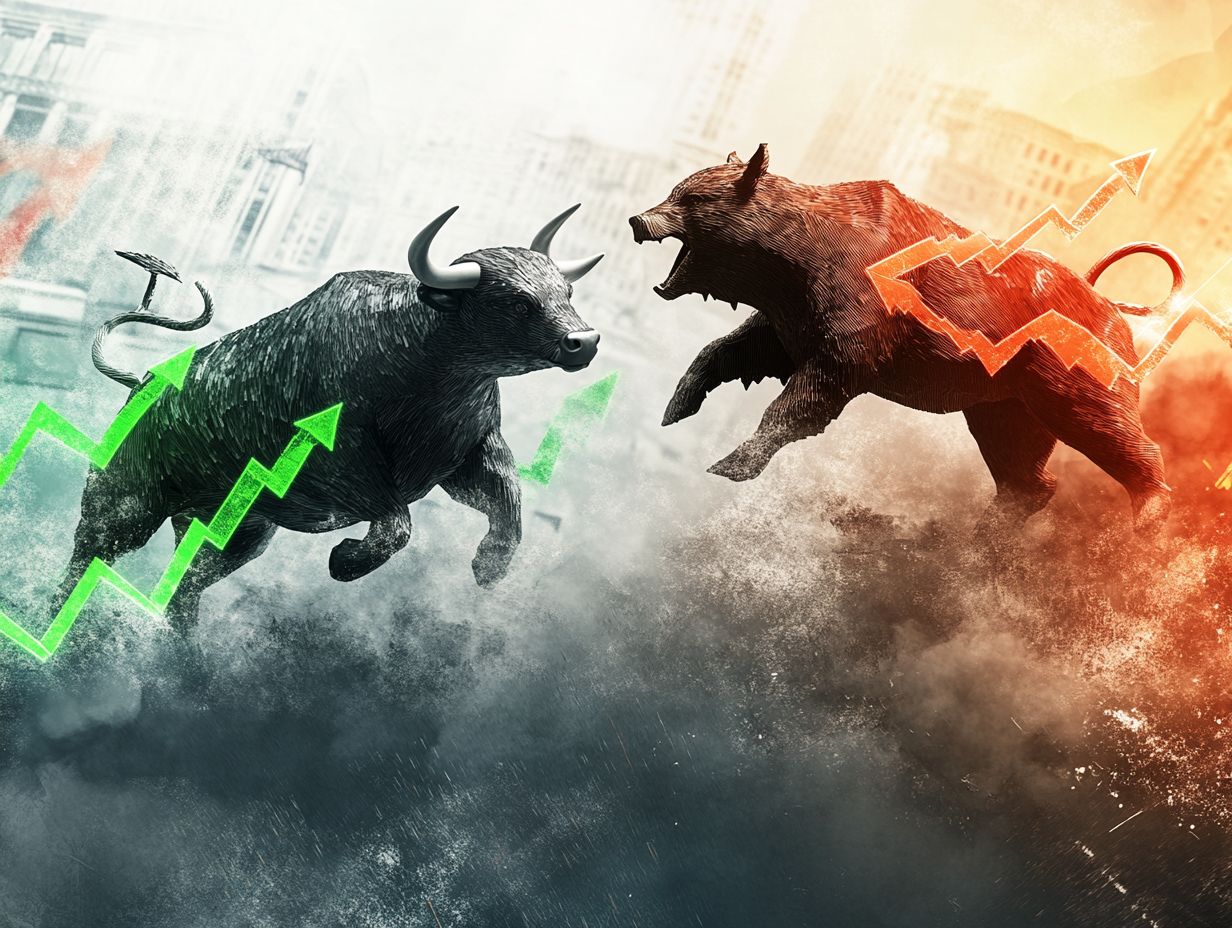What is a Bull Market and a Bear Market?
Get ready to unlock the secrets of market trends! Navigating the world of investing can feel overwhelming, particularly when it comes to deciphering market trends. This article simplifies the essentials of bull and bear markets, allowing you to grasp their defining characteristics with ease.
It highlights key indicators that signal these market trends, explores the factors that drive shifts, and offers actionable strategies for investing in both climates.
Whether you are a seasoned investor or just beginning your journey, this guide will empower you with the knowledge needed to make informed decisions and optimize your returns.
Contents
- Key Takeaways:
- Understanding Market Trends
- Characteristics of a Bull Market
- Characteristics of a Bear Market
- Causes of Bull and Bear Markets
- Strategies for Investing in a Bull or Bear Market
- Frequently Asked Questions
- What is a Bull Market and a Bear Market?
- How do you know when it’s a Bull Market or a Bear Market?
- What causes a Bull Market and a Bear Market?
- What are the characteristics of a Bull Market and a Bear Market?
- How long do Bull Markets and Bear Markets last?
- What should investors do during a Bull Market or a Bear Market?
Key Takeaways:

- A bull market is a financial market where the overall trend is upward, with increasing prices and investor optimism.
- A bear market is a financial market where the overall trend is downward, with decreasing prices and investor pessimism.
- Understanding market trends and identifying key indicators can help investors make informed decisions and develop successful strategies for investing in both bull and bear markets.
Understanding Market Trends
Grasping market trends is essential for successfully navigating the investing landscape, as these trends often dictate stock market behavior and shape investor psychology.
They can indicate whether you re entering a bull market, where stock prices are on the rise, or a bear market, characterized by declining prices. This awareness significantly impacts market conditions and your investment strategies.
By recognizing these trends, you can adeptly adjust your portfolio and identify opportunities that align perfectly with your investment objectives.
Defining Bull and Bear Markets
A bull market is marked by rising stock prices and an atmosphere of investor confidence, often fueled by favorable market conditions and robust economic activity.
Conversely, a bear market signifies falling stock prices and a prevailing sense of pessimism among investors. In a bull market, you’ll typically find optimism reigning supreme, prompting increased spending and investment.
People and organizations operate under the belief that rising prices are here to stay for the long haul. On the flip side, bear markets often emerge during economic downturns, such as the Great Recession of 2007-2009 or the burst of the Dot-com bubble in 2000.
During these periods, uncertainty and fear grip investors. Many sell off their holdings to mitigate losses, which only exacerbates the decline in stock prices. Grasping these dynamics is crucial for you as an investor; market trends and sentiment play a vital role in shaping your strategy and decision-making process.
Characteristics of a Bull Market
In a bull market, you ll notice a few key characteristics: stock prices consistently rising over an extended period, a surge in investor confidence, and favorable economic conditions that drive market performance.
This prevailing optimism often results in heightened consumer spending and a strong investment strategy, as investors eagerly pursue positive returns.
Understanding these traits can help you spot opportunities early!
Key Indicators and Trends

Key indicators and trends in a bull market often include rising stock prices, increased investor optimism towards bullish investments, and favorable conditions for effective investment management.
As the market rallies, one of the most telling signs is the rise of major stock indices like the S&P 500 (a stock market index that measures the stock performance of 500 large companies listed on stock exchanges in the U.S.) and the Dow Jones.
When these indices show consistent upward trends, it tends to create a bullish atmosphere among investors. Heightened consumer spending often signals greater confidence in the economy, prompting businesses to expand and hire more. This sets off a positive feedback loop; as companies grow, their stocks typically climb, drawing in even more investors.
Take the post-pandemic recovery as an example many tech stocks experienced a remarkable surge, showcasing how market dynamics can significantly influence investor sentiment.
Characteristics of a Bear Market
In bear markets, you ll notice a pronounced downturn where stock prices consistently decline. This environment fosters a heightened sense of caution among investors, often leading them to gravitate towards investments expected to decline in value.
As a result, you may find yourself reevaluating your investment strategies, driven by the apprehension of further price fluctuations.
Key Indicators and Trends
In a bear market, you ll often notice key indicators and trends that include declining stock prices, increased investment risks, and significant market corrections that reflect the actions of bearish investors.
These fluctuations can frequently be linked to specific economic indicators, such as rising unemployment rates, falling consumer confidence, and disappointing earnings reports from major corporations. Historical examples like the 2008 financial crisis serve as stark reminders of how plunging indices and deteriorating economic conditions can foster a pervasive sense of fear among investors, prompting them to withdraw their capital.
Shifts in investor sentiment seen in declining market volumes and increased short-selling show the arrival of tough market conditions. This underscores the importance of staying informed and vigilant in navigating these turbulent waters.
Causes of Bull and Bear Markets
The causes of bull and bear markets are complex and multifaceted, shaped by a blend of economic activity, investor confidence, and the intricate dynamics of the market.
By grasping these underlying factors, you can make informed decisions and skillfully navigate the inevitable fluctuations of the market.
Factors that Influence Market Trends

Several factors influence market trends, including economic activity, shifts in investor psychology, and historical market patterns that can inform your investment management strategies.
Macroeconomic indicators, such as unemployment rates and GDP growth, play a crucial role in shaping your perception of economic stability. For instance, if you notice a dip in manufacturing output, it might lead you to adopt a bearish outlook, prompting more cautious trading behavior.
Social trends, like the growing emphasis on sustainability, can drive your demand for green investments, reflecting your shifting preferences as a consumer. Additionally, historical precedents, such as the 2008 financial crisis, often serve as cautionary tales for you, influencing your current investment strategies as you seek to avoid similar pitfalls.
Understanding these dynamics is essential for you to navigate the complexities of modern markets effectively.
Strategies for Investing in a Bull or Bear Market
Crafting effective strategies for investing in both bull and bear markets is crucial for maximizing your returns and managing risk. This is your chance to capitalize on opportunities!
In a bullish environment, you might lean toward high-quality stocks that promise growth, while in a bearish market, it may be wise to consider defensive stocks or investing a fixed amount regularly (investing a fixed amount regularly, regardless of market conditions) to safeguard your investments.
Balancing these approaches can significantly enhance your financial outcomes.
Tips for Maximizing Returns
To maximize your returns in fluctuating markets, you should embrace robust investment management techniques that involve selecting high-quality stocks and responding adeptly to price changes.
This requires a comprehensive approach that emphasizes strategic asset allocation tailored to current market conditions. In bull markets, concentrating on growth-oriented stocks can yield remarkable returns; conversely, during bear markets, pivoting towards defensive assets like utilities or consumer staples can safeguard your capital.
Continuously analyzing market performance indicators, such as the S&P 500 and other relevant indices, will empower you to grasp trends and make informed decisions. By staying aware and adaptable, you can proactively adjust your portfolio, ensuring not only that you navigate market swings but also that you seize emerging opportunities.
Frequently Asked Questions
What is a Bull Market and a Bear Market?

A Bull Market is when prices of stocks, securities, and commodities are rising. Investors feel optimistic about the future.
A Bear Market is the opposite. Here, prices are falling, and investors are often more pessimistic.
How do you know when it’s a Bull Market or a Bear Market?
There are no strict rules to define when a Bull or Bear Market starts or ends. Experts check stock market trends, economic indicators, and overall investor feelings to make their judgments.
What causes a Bull Market and a Bear Market?
A strong economy, low unemployment, and high consumer confidence often lead to a Bull Market. In contrast, a Bear Market can be caused by things like a recession, high inflation, or geopolitical events.
What are the characteristics of a Bull Market and a Bear Market?
In a Bull Market, stock prices rise, trading volumes are high, and investors are generally positive.
During a Bear Market, stock prices fall, trading volumes drop, and investors tend to be more cautious.
How long do Bull Markets and Bear Markets last?
Bull Markets can last for months or even years. Bear Markets can last for several months to a few years as well, but there s no fixed timeframe, and trends can change suddenly.
What should investors do during a Bull Market or a Bear Market?
In a Bull Market, consider buying stocks and holding them long-term.
In a Bear Market, it s smart to diversify your investments and focus on stable assets like bonds or cash. Always consult with a financial advisor before making any investment decisions.






